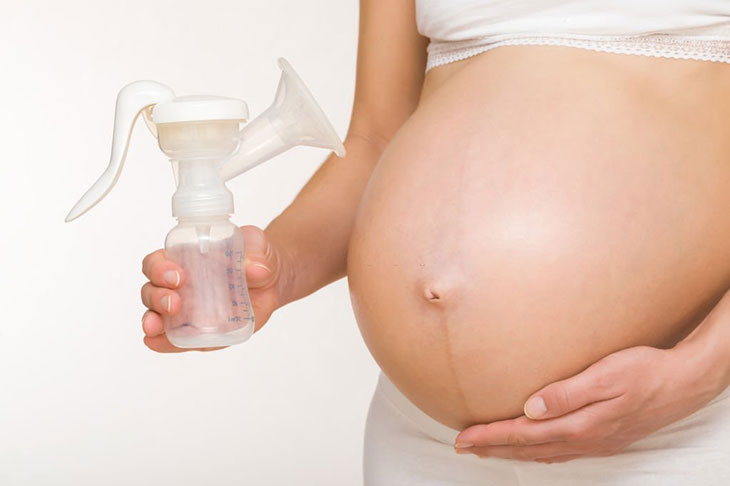Labor is a naturally occurring process, but the mother still has no signs in some cases, even though the fetus is full-term.
This is when you need some help. Your doctor may recommend pumping to induce labor instead of medication. But is it safe, and how is it done?
Scroll down and get the answer.
What Is A Breast Pump To Induce Labor?

The stages of labor are a natural occurrence, but in some cases, it is close to the due date, and there are still no signs. This makes the mother more worried and insecure.
There are many ways to make childbirth easier when a woman has long or difficult labor.
To make this process go smoothly, learning about the fastest way to induce labor is the basic knowledge that any pregnant mother needs.
According to experts in the field of obstetrics and gynecology, there are many ways to induce labor, such as using supportive drugs, acupressure pressure points, nipple reduction, etc.
Among them, nipple stimulation with the pump to induce labor is one of the most trusted methods by many doctors today because it is suitable for most women in the final stages of pregnancy.
Using a breast pump or stimulating the nipples by hand or mouth can cause the breasts to release the natural hormone Oxytocin. This love hormone helps the uterus contract and promotes.
Studies in 2005 and 2014 showed that using a breast pump to induce labor increased the rate of vaginal birth.
How To Perform Pumping To Induce Labor?
The principle of this method is to use a breast pump to massage the areola area and stroke the nipple almost like a baby sucking.
Stimulating and releasing Oxytocin levels will promote uterine contractions because the body mistakenly thinks you are breastfeeding.
According to experts, there is no specific rule when performing the pumping for the labor induction process because it depends on the health status of the mother and fetus.
But usually, it will take place in the following three steps:
- Place the tip on the correct nipple and adjust it to feel comfortable.
- Suction both breasts one at a time or simultaneously (depending on your chosen machine design) for 15 minutes each.
- Rest for 5 minutes and continue stimulating nipples and breasts for 1 hour.
Don’t expect strong contractions to happen. If the contraction occurs, pause and wait until the feeling stops for the body to adapt.
Do not forget to clean the breast area and instruments carefully before performing.
Is It Safe To Pump To Induce Labor?

Pumping is one of the methods to prefer natural labor, so it is generally safer and has fewer side effects than using some drugs like Oxytocin or Dinoprostone.
This is a proven physical and mechanical method, and its benefits are relatively obvious, but it can bring a lot of discomfort in the chest for pregnant women.
Not all pregnant women can apply this method.
To determine which method is most suitable for each pregnant woman, the doctor will review the medical history, obstetrics and gynecology, the mother’s comprehensive health, the condition of the cervix, the estimated fetal weight, and pregnancy status.
It would be best if you did not ask for an early induction or do it yourself at home because only your doctor can determine the exact outcome of the pregnancy test.
The best time to perform breast pumps to induce labor is 40 weeks.
According to Staten Island University Hospital studies, pregnant women should not use these methods before 39 weeks of pregnancy.
It is also unsuitable for umbilical cord prolapse, breech pregnancy, women with herpes infection, or a history of uterine surgery.
How Often Should I Pump To Induce Labor?
Although it is a method of natural stimulation by physical impact, it still causes uncomfortable sensations for pregnant women’s breasts, especially those in the stages of labor.
Doctors do not encourage mothers to abuse this method to achieve faster results.
You can repeat the operations we instructed above for about 3 days. Remember not to do it more than 3 times a day and each time for no more than an hour.
When stimulating the nipple for uterine contractions with a pump, the mother should adjust the suction to a moderate level.
Too much force can cause pain and damage to the breast, but too little pressure is not enough to stimulate the nerves in the nipple.
This week is only approximate, so you need to consult your doctor to avoid causing complications for the fetus. Don’t force yourself to do it.
Pregnant women should pay attention not to apply the natural induction methods when the fetus is not yet full-term, which can easily lead to premature birth and unsafe for the mother’s health.
When Can You Start Pumping While Pregnant?
Induction of labor is indicated when it is more beneficial to the mother or child than to continue to hold the late pregnancy in the mother’s womb.
The exact time when nipple stimulation can be performed depends on the doctor’s decision based on the condition of the mother and fetus.
Medical centers may suggest that pregnant women perform it in some of the following cases:
- Pregnancy past due date (usually past 40 – 42 weeks) but still no signs or yes but very slowly
- When the amniotic sac has ruptured, no uterine contractions appear. Immediate induction of normal labor is required because the mother and fetus will have risk factors for infection.
- Pregnant women have preeclampsia, high blood pressure during days of pregnancy, and diabetes, which seriously affects the life of both the baby and the mother.
- Examination shows that your uterus does not have enough amniotic fluid.
- Fetal heart records abnormalities.
- The mother is a patient with hypertension, diabetes, etc.
Other cases need to induce labor with drugs that the doctor must examine and make the most accurate conclusions to ensure the safety of both the pregnant mother and the baby.
FAQs:

How Long Will I Go Into Labor After Pumping?
When the body is ready, uterine contractions can come a few hours after the procedure. On the contrary, it can take place after 1-3 days.
This process can also fail, so immediately notify the medical facility.
How Long Does The Pumping Process Take?
You should do it up to once an hour, no more than 3 times a day, and only for 3 days.
Conclusion
We can see that pumping to induce labor is a safe, natural method to promote faster contractions.
Pregnant women at the end of healthy pregnancy should regularly visit the hospital to receive the doctor’s advice and have the most favorable birthing process.
